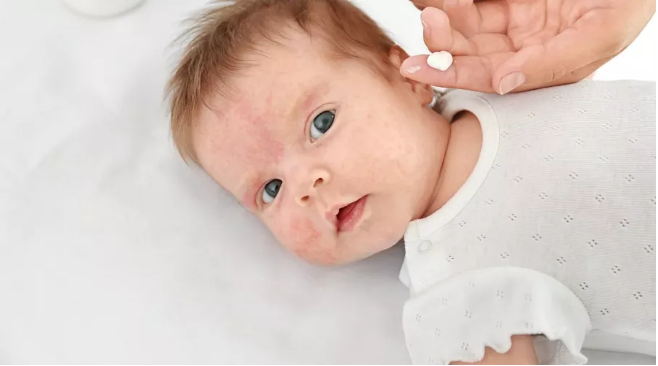Winter is coming, and the pediatric clinic will always be a group of people who take the baby to see a doctor. Nine times out of ten, the baby who was held or held by his parents was pasted with a blue antipyretic sticker on his head, and the appearance of grievance on his face really made people feel distressed.
Today, I saw another mother coaxing a crying child to stick an antipyretic sticker. The child didn’t want to, but the mother always stressed that [the baby is good, it won’t be hard to stick it on]. Clearly, the child’s head was small and obviously had an allergic reaction!

[The child has an allergic reaction, don’t post it to him] I stepped forward.
[How can you do it without sticking it? Only after sticking it can you reduce your fever! ] When my parents saw me wearing a white coat, the original excited tone gradually weakened, [Isn’t it…]
Poor inherit the wind, but is this antipyretic paste trusted by many parents really an antipyretic artifact?
Why does the child have a fever?

To clarify this problem, we must first understand why the child has a fever.
Fever is not a disease, it is a symptom.
When viruses, bacteria, etc. invade the body, in order to combat inflammation, the body’s body temperature will rise. This will not only slow down the activity and reproduction of pathogenic microorganisms, but also strengthen the human immune system, including the increase of white blood cells, phagocyte and neutrophils.
Therefore, fever is actually a protective mechanism of the human body. Forcibly cooling the temperature to prevent the body from fever is not conducive to the recovery of the disease.
We reduce the fever for the baby, mainly to relieve the physical discomfort caused by fever, not to cure the disease.
Can antipyretic paste reduce fever?

Now, let’s go back to this issue and talk about whether antipyretic stickers can reduce fever.
1. Principle of antipyretic patch
The core component of the antipyretic patch is the volatile liquid gel layer.
If the gel is enlarged, it is like a hornet’s nest. There are many holes in these holes, which contain a large amount of volatile components. When the antipyretic patch is attached to the skin, the heat on the skin surface is taken away by the volatilization of the volatile components, thus reducing the temperature of the local skin.
In short, it is a kind of [physical cooling].
However, the physical cooling effect is not as good as antipyretic and can only be used as an auxiliary antipyretic method.
Such as antipyretic patch, which relies on a small amount of local skin heat dissipation, does not play a big role in what of the child’s body temperature. After all, the temperature in the human body will reach a balance through the flow of blood. It is impossible to reduce the brain temperature or even the body temperature by cooling a small piece of skin on the forehead.
2. Domestic and foreign guidelines have never recognized antipyretic stickers.
In foreign countries, no matter in the American Academy of Pediatrics, the Canadian Association of Pediatricians, or the National Institute for Health and Clinical Excellence (NICE), there is any mention of antipyretic patches in the coping methods for children’s fever.
In the Guidelines for Children’s Fever issued in our country-< < Evidence-based Guidelines for Diagnosis and Treatment of Certain Issues Concerning Acute Fever of Unknown Etiology for Children Aged 0 to 5 Years Old in China (Standard Edition) > > (2016), there is no antipyretic patch at all regarding the treatment of children’s fever.
3. Antipyretic patch is not a medical product and may cause allergy.
In fact, antipyretic patches do not belong to medical products, and naturally there will be no relevant medical departments to supervise its production and sale.
In addition, some antipyretic patches will also add ingredients such as borneol, mint and eucalyptus oil to make the antipyretic patches feel cooler on the skin.
For some babies, this can really bring a little comfort, but not all children are applicable!
These added ingredients are easy to cause skin allergic reactions, such as rash and redness. For this part of the baby, insisting on using antipyretic patches will not only not reduce fever, but also endure more pain for no reason.
Antipyretic patch is only a placebo for parents to relieve their anxiety about their children’s illness.
What if you burn your brain without antipyretic stickers?

We also often hear parents say:
A child’s fever will burn his brain out! We have to use antipyretic stickers to cool Eva’s brain.
In fact, there are three conditions of fever that may affect children’s brains:
1. Encephalitis, fever caused by meningitis
The disease itself will affect the child’s brain, not the neurological sequelae caused by fever.
2. Febrile convulsion
Long-term febrile convulsion may cause convulsion persistence and cause brain damage.
3. Heat stroke
The core body temperature of heat stroke is usually not lower than 40 ~ 41 ℃, accompanied by central nervous system dysfunction.
In these serious cases, no doctor will recommend you to use the antipyretic patch, because it can only cool down temporarily or locally and will not fundamentally touch the [regulatory center] that controls body temperature.
After all, the prices of antipyretic stickers on the market are not cheap now. Compared with its insignificant [antipyretic effect], it is better to take the money to buy some delicious and fun for children.
Seeing this, many parents may be upset. What if they hoard so many antipyretic stickers at home?
Although antipyretic patch cannot reduce fever, it still has a function:
Sticking an antipyretic patch to her is equivalent to writing brightly on her head: “My baby has a fever, so don’t approach strangers.”
For older children, by putting on an antipyretic patch, the baby can realize that she is ill, no longer scampering, and becomes clever in an instant.
